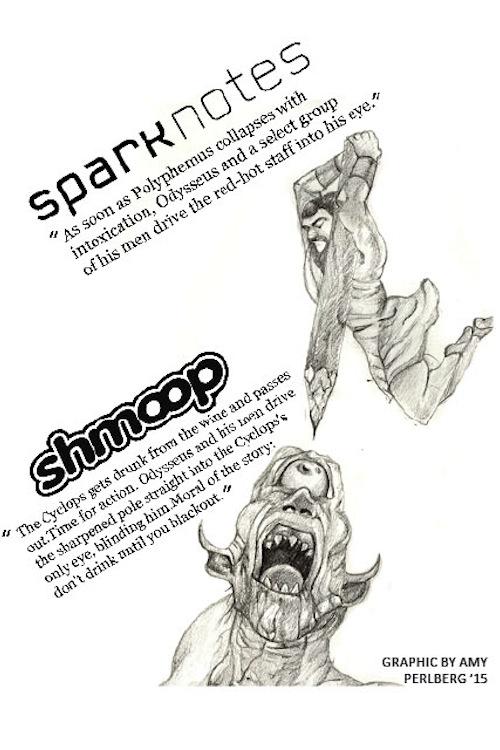It’s a site that combines Victor Frankenstein with a hipster, refers to George Orwell “ROFL-ing” and suggests that Lady Macbeth try a little hydrogen peroxide for her damned spot.
Shmoop, an online learning resource that provides bulleted summaries and reference pages with a thorough dose of academic sass, has gained popularity with students, incorporating itself into the internet canon of Sparknotes, Gradesaver, and Bookrags.
“Who doesn’t want their English books to be joked about by a website that also teaches you so much?” Nathan Francis ’14 said.
From its name–which comes from the Yiddish saying, “move things forward”–to its format, the site, founded in 2005, is unique. “It was created so that people can have fun learning,” Christina Park, Vice President of Marketing at Shmoop, said in a telephone interview. “It’s where you can go when you want to bang your head against your textbook.”
The site’s book summarizing bullet points are imbued with snarky voice. The unique format of the site appeals to students, including Francis, who used it as a resource while reading “Jane Eyre.”
“I went on Shmoop because Charlotte Bronte was killing me,” Francis said.
Marcel Massarani ’16 appreciated Shmoop’s compressed format. “Sparknotes is too long,” he said. “If you’re too lazy to read the book, you’re also too lazy to read Sparknotes.”
Despite Shmoop’s bulleted summaries, users noted the thoroughness of the site, which often includes more specifics than other sites, providing minutiae of conversations and direct quotes from books. “Shmoop has every single detail,” Julia Schorr ’16 said.
Some teachers felt that Shmoop’s analysis was actually superior to points made on Sparknotes. “Shmoop is a much better resource than Sparknotes, if it’s used properly,” English teacher Barbara Robbins said.
Shmoop is gaining users, growing at a rate of about 50 percent each year and with 7 million unique visitors per month. “Increasingly, kids are finding it,” English teacher Meghan Scheck said. “But Sparknotes is still the old standby.”
Scheck said she felt that Shmoop was the next step in an evolution. “In the 90s to 2000’s there was a shift from CliffsNotes to Sparknotes. CliffsNotes were dry and teachery and boring, and Sparknotes was a little different. Shmoop is like the next stage,” she said.
However, many students have either never heard of the site or are still steadfast Sparknotes users.
Some preferred the more linear organization of Sparknotes’ summary and analysis compared to Shmoop’s separation of plot and theme. “I feel like everything is in one place,” Emma Tangel ’16, who is loyal to Sparknotes, said.
Scheck said that she would use Sparknotes as a supplemental resource for a student who was having more trouble with a book academically, as the old staple has a more objective voice and can have longer summaries. She would use Shmoop as more of an interest hook. “Romeo and Juliet might not sound so boring if it has snarky comments built in,” Scheck said.
Some, however, are not so hooked by Shmoop’s voice. “I was reading ‘The Odyssey’ and there was this awkward scene where they kissed. Shmoop was like ‘eww,’ and it wasn’t very mature,” Julia Ethier ’17 said. Ethier found the side comments “annoying.”
Although students may have a strong preference, some teachers feel that the two sites’ usage should be limited. “Both can be abused,” Scheck said.
Robbins encouraged using in-class resources and discussion to persist through a tough reading. “Rather than turning online, trying to push through confusion and coming up with your own questions is preferable,” Robbins said.
“I’d much rather have students come in confused than come in and regurgitate information,” English teacher Kim Herzog added. “It’s important for them to learn how to persist through that.”














































